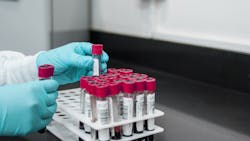The British Medical Journal has published studies, conducted in Sweden, on the risks of developing deep vein thrombosis, pulmonary embolism, and bleeding after experiencing COVID-19, according to a news release.
This study found an increased risk of a first deep vein thrombosis up to three months after COVID-19, pulmonary embolism up to six months, and a bleeding event up to two months, with the risk of pulmonary embolism in the acute phase being especially high.
This study used a nationwide cohort consisting of all people who tested positive for SARS-CoV-2 regardless of disease severity.
The incidence of risk during the period before exposure to SARS-CoV-2 (days −3 to day 0) were found to be high for all three outcomes, driven by an increased number of events at day 0. Some of the patients with these high risks were likely infected with SARS-CoV-2 before the event. However, because including day 0 in the risk period would introduce test bias, we excluded this day and incorporated it in the pre-exposure period. In addition, risks were observed to be increased during the buffer period (−30 to −4 days), probably because of a delay in testing or documentation of COVID-19 diagnosis, or due to reverse causality (i.e., nosocomial COVID-19).
Furthermore, we compared the risk of outcomes among the different pandemic waves and found the incidences or risk to be higher in the first wave, especially during the acute phase of COVID-19. This could be explained by improvements in the treatment arsenal against COVID-19, especially the widespread use of thromboprophylaxis after the first wave. Additionally, we found an excess risk of outcomes in patients with more severe COVID-19 admitted to hospital, but especially in those admitted to an intensive care unit. The rates for venous thromboembolism in this patient group have been shown to be high despite thromboprophylaxis.
We acknowledge limitations to our study. Firstly, registry-based information is at risk of containing incomplete or inaccurate data. Secondly, venous thromboembolism may have been underdiagnosed in patients with COVID-19. Critically ill patients may be too unstable for diagnostic evaluation of venous thromboembolism, or the evaluation might be delayed owing to contagiousness issues.
Furthermore, as registry data for control participants was limited to 1997, events might have more often been falsely classified as first events in the control participants, possibly resulting in underestimation of the risks. However, overestimation of the risks might also exist owing to limited testing for COVID-19, especially during the first pandemic wave. In addition, vaccine data were not available for our study. By week 17 (30 days before the end of our data), 30.3% of the population aged 12 years or older had received their first vaccine dose (Swedish Public Health Agency data).
The vaccines were prioritized for elderly people primarily, therefore the distribution of vaccines was increased in elderly age groups compared with younger age groups. As we found that older people have an increased risk of deep vein thrombosis, pulmonary embolism, and bleeding, it is possible that vaccine coverage provides a protective effect in age groups older than 50 years. Potentially this could partially explain why the incidence rate ratios were lower (at least in the acute phase) during the third pandemic wave. Moreover, we acknowledge residual confounding as a limitation to our study. However, the similarity of the results between the matched cohort study and self-controlled case series analysis, which controls for all confounders that might be regarded as fixed during the study period (thus including body mass index and smoking) suggests that these are not major confounders. Furthermore, the results remained unchanged when adjusting for specific comorbidities from the Charlson comorbidity index.
Previous studies have shown an association between thrombosis and infections. The risk of events in our study was, however, observed to be much higher. This could be explained by several pathophysiological alterations in COVID-19, such as a direct effect of the virus on endothelial cells, an exaggerated inflammatory response, down regulation of angiotensin converting enzyme 2 receptors, and activation of the coagulation system. Although deep vein thrombosis and pulmonary embolism traditionally belong in the venous thromboembolism spectrum of disease, the relative incidence of pulmonary embolism was much higher, which could be due to immunothrombosis (thrombosis in the pulmonary vessels from local inflammation). The increased risk of bleeding could be related to endothelial dysfunction, coagulopathy, or disseminated intravascular coagulation.

